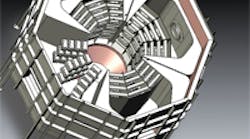Consolidated Engineering Company (CEC) first designed and patented a 3-in-1 heat treatment system in the 1990s known as the Sand Lion®. The automatic machine could simultaneously remove mold and cores from castings, heat treat the casting, and reclaim the mold and core sand for subsequent use. In 2005, the company improved on this concept, creating the CleanCast® system, a solution heat treatment system is based on three core concepts that together enable energy efficiency, excellent uniformity, reductions in emissions and reclamation of both heat and sand.
The first core principle for the CleanCast system is the location of the system in close proximity to the casting stations. This enables the castings to be loaded into the furnace directly after pouring, utilizing the retained heat from the molten metal to decrease the heat up time of the furnace and castings to the treatment temperature. This is called the Process Critical Temperature (PCT) principle. The PCT principle is based on removing the part at a temperature just before the alloying elements begin to diffuse out of solid solution, that is, shortly after solidification. (It has been found that for every minute the casting cools below the PCT, an additional three to five minutes of soak at solution treating temperature may be required.)
The second core principle is the elimination of superfluous equipment and reclamation, and recycling of any assets possible through out the process. This can be accomplished in several ways. One is the elimination of baskets, trays, and racks that are traditionally used to convey parts through the furnace. CEC has two different options to convey parts (cell unit and chain conveyor) through the furnace without baskets or trays. This saves cost in the purchase and maintenance of these items, as well as reducing energy required to heat up these additional pieces in the furnace. This equipment elimination saves an average of 12% of electrical energy, and approximately 45% of gas/heating energy annually.
The reclamation and recycling of mold and core sand and heated air are also key. Using high-pressure air impingement nozzles, sand molds are quickly removed from the casting thereby decreasing the time — by at least 50% — required to conventionally process the casting. Careful analysis of airflow patterns has optimized the patented technology, allowing the efficient use of radial fans for air recirculation combined with closely positioned air nozzles to impinge directly onto the castings. In this way, hot, high-velocity turbulent air removes mold and cores without knockout damage.
System recycling is achieved by purifying removed casting sand with heat and fluidizing air. Since the chemical sand binder is a hydrocarbon, the binder is burned as a fuel in the system, which allows the use of its heat for heat treatment and sand reclamation and simultaneously destroys many of the binder chemicals. This not only enables the sand to be reclaimed for further use, but binder agents and residue are burned away and effluent pollution is avoided. Up to 60% energy savings are not uncommon and more than 40% of the used energies are recycled. Typical recycling efficiency is 98%, returning sand for direct reuse to make more molds and cores.
The third principle is the careful, well planned design creates a superior product. Each system that is engineered is designed to meet and exceed the customer’s needs and create a superior end product. With our new basketless designs, we can produce smaller more flexible equipment that can fit into any shop floor space.
Our 3-in-1 capabilities and close proximity to casting units mean that the labor required to process parts is reduced while at the same time increasing uniformity and shortening heat treatment time. There are two options when it comes to the conveyance of parts through the furnace. The first is a cell unit, which has no moving parts inside the furnace making it an ideal fit for castings that have castings with cores. The second is a chain conveyor system for parts that do not have cores. This system is the best because the parts are placed on chains; air is allowed to circulate freely giving the customer an excellent part to part uniformity.











